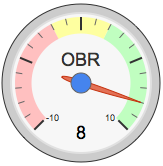
The GNOME Project
Dave Neary has kindly agreed to supply data for an Open-By-Rule evaluation of the GNOME Project, which develops and maintains one of the two open source graphic desktop environments most widely used on UNIX and Linux systems as well as a diverse and growing range of other software including notably mobile software. The scores are mine, although they are largely based on Dave’s assessment.
GNOME easily scores +8 and is obviously open-by-rule.
| Rule | Data | Evaluation | Score |
|---|---|---|---|
| Open, Meritocratic Oligarchy | The GNOME project is ostensibly led by the Release Team, an open body to which the remaining team members invite someone on merit when a seat opens. Each module in GNOME also has its own maintainer team which decides on the direction of the modules they maintain. The GNOME Foundation is governed by an elected board, elected for a term of 1 year. | Newcomers to GNOME often have trouble figuring out who’s in charge. The Release Team is responsible primarily for the release process and has not traditionally set any strategic direction for GNOME, and individual module governance rules are varied. The foundation board is responsible primarily for maintaining the infrastructure of the foundation, and dealing with sponsors and benefactors, and does not set any technical direction. Score: Governance is open, membership of the release team oligarchy is meritocratic – scoring zero for oligarchy because much of the governance is devolved to maintainers, making it hard to figure out how to accomplish project-wide change. |
+2 |
| Modern license | Applications are released under GPL v2+, development platform libraries are LGPL v2.1+ | GPLv2 is widely regarded as providing contributor patent protection through implied licensing. Changing the licensing of GNOME to anything other than (L)GPL v3+ (which would not require the permission of all contributors) would be very difficult. | +1 |
| Copyright accumulation | GNOME does not accumulate copyrights. Authors keep their own copyrights. | Clearly scores +1. | +1 |
| Trademark policy | Licensing Policy | The GNOME Foundation has registered a small number of trademarks. The foundation has drafted “fair use” trademark guidelines, and a click-through trademark licence for a number of standard community activities – setting up a fan website or usergroup, printing GNOME merchandising, etc. All of GNOME’s trademarked artwork is available under a copyleft licence to anyone using the project. GNOME has entered into a number of legal agreements in a transparent manner (including publishing the trademark licenses afterwards) to allow companies to sell GNOME branded t-shirts & goodies.
Score: Community-equal policy scores a clear +1. |
+1 |
| Roadmap | The marketing & release teams have worked for several release cycles to develop a community roadmap. | The roadmap includes the plans of individual modules, and gives developers the opportunity to identify themes. However, the lack of a medium to long term vision of the project has often been cited as a failing. The move to GNOME Shell has given the project some forward-looking momentum.
Score: Good start, will score +1 one day… |
0 |
| Multiple co-developers | The GNOME project has seen commits by over 3000 developers in its history. The project has vibrant co-operation among competitors, and a healthy mix of 30% paid developers and 70% unpaid contributors. | Obviously excellent, +1. | +1 |
| Forking feasible | GNOME is made up of hundreds of modules with a diverse developer community. The GNOME platform and applications have been used as the basis for projects including Maemo, Sugar, Moblin/MeeGo Netbook, and Ubuntu Netbook Remix. | Forking GNOME completely would be a mammoth task. However, by taking a common set of core modules and differentiating only in the UI, a number of companies have created GNOME-based derivatives. Arguably, Canonical is doing this with Unity/Compiz being included in Ubuntu 11.04. So probably +1 score. | +1 |
| Transparency | GNOME work is done on mailing lists, on IRC, in Bugzilla and in a public git repository | While there have been some issues with discussions happening on IRC, or with colleagues working on features together before pushing them to public git, in general, the entire operation of the GNOME project happens in publicly archived mailing lists or in Bugzilla comments.
Score: Given the controversy that has arisen in the past from the easy access to GNOME community’s dialogues on, for example, FSF affiliation, it clearly has to score +1. |
+1 |
| Summary (scale -10 to +10) | +8 |
Filed under: Governance | Tagged: GNOME, Open-By-Rule |






[…] – given that GNOME is a project which scores very highly as being Open By Rule (disclosure: I put together the evaluation of GNOME for Simon), I thought I would go back through […]
Why do you choose for the words:Copyright accumulation? I think you mean to tell something about ownership: single entity or a complex ownership model. In my view, Copyright assignment is a matter of ownership.
[…] I evaluated GNOME’s governance for Simon Phipps recently, I scored the project 0 (on a scale of -1 to 1) for the criteria of […]